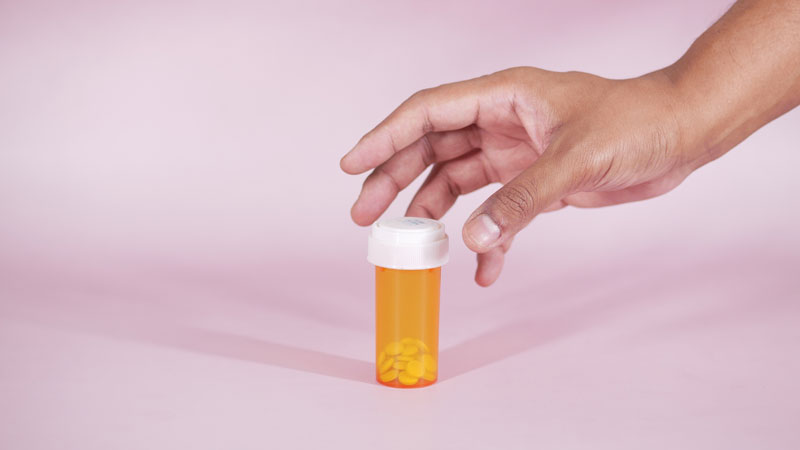Substances | 5 min read
What Is Gabapentin, And What Is It Used For?
Medically Reviewed By

On October 16, 2023
Written By
On October 16, 2023

What you will learn
- Gabapentin is an oral anticonvulsant or muscle relaxer that is also sometimes prescribed to treat pain.
- It is a Schedule V drug and is considered a controlled substance with a much lower potential for abuse than opioids.
- Gabapentin has minimal side effects for most people and is suitable for long-term pain relief.
- This pain medication is often offered as an alternative to opioids or narcotics for those who struggle with opioid use disorder or suffer from alcohol withdrawal symptoms.
- While there is a low potential for addiction, it is not impossible to become dependent on Gabapentin if misused.
What is Gabapentin, and What is it Used For?
Gabapentin was initially approved as a muscle relaxant and anti-spasmodic. [1] It was soon discovered that this medication had many more practical uses, including treating seizures, restless leg syndrome, and different types of pain. It is also considered a safe medication relative to stronger painkillers like opioids.
What Does Gabapentin Look Like?
Gabapentin is a small white pill or capsule. However, it may sometimes be yellow, or be half white and half yellow.
What Dosages Does Gabapentin Come In?
The starting dose for treating neuropathic pain is typically around 900 mg per day, but this can vary based on individual needs and medical guidance. The gabapentin dosage may be between 1,000 and 3,000 mg for treating seizures.
What Is The Brand Name For Gabapentin?
Neurontin is the brand name for this drug. Both the generic and brand name versions do the same things.
How Does Gabapentin Work?
Gabapentin’s mechanism of action includes modulating certain neurotransmitters in the central nervous system (CNS), which comprises the brain and spinal cord. These structures are crucial for coordinating thoughts, movements, and numerous essential functions required for daily life.
In some individuals, the CNS may function abnormally, leading to conditions such as overactive nerve signaling. This can manifest as seizures, chronic pain, and other neurological issues. Gabapentin interacts with specific calcium channels in the nervous system, not by globally ‘slowing down’ the CNS, but by altering the release of neurotransmitters that contribute to hyperexcitability. This action helps to stabilize neural activity, thereby managing the symptoms of conditions like epilepsy and neuropathic pain.
Although gabapentin does not cure underlying neurological conditions, it plays a significant role in reducing their intensity and impact on patients.
What Kind of Pain Does Gabapentin Treat?
Neuropathic Pain or Neuropathy
Gabapentin is particularly good at reducing neuropathic pain.[2]
Neuropathic pain is not your average kind of physical discomfort. Instead of causing minor muscle aches and soreness, it targets the nerves throughout your body. The feeling of neuropathic pain also differs from chronic pain caused by excessive exercise or injury. It often manifests itself as a burning or shooting pain. Some may also experience a sensitivity to touch and feel pain when exposed to non-painful stimuli, such as a light touch of the arm.
Traditional pain relievers like Tylenol® (acetaminophen) are often less effective in treating neuropathic pain compared to medications like gabapentin.
Postherpetic Neuralgia
Gabapanetin is specifically approved to treat postherpetic neuralgia, which can occur after a shingles attack. Though most people recover within a year, it may last longer. It is characterized by burning and tingling pain. When prescribed off-label, gabapentin may also treat fibromyalgia, PTSD, anxiety, and many other conditions.
Who Should and Shouldn’t Take Gabapentin?
Gabapentin is safe for most people, but to be as safe as possible, it is best to use it for its approved uses. The FDA approved this medication to treat postherpetic neuralgia, restless leg syndrome, and partial seizures. However, some doctors may use the drug for off-label treatment.
While off-label use of gabapentin is not uncommon and can be beneficial for certain conditions, it should be undertaken with caution due to the potential for increased risk of adverse effects and insufficient evidence for certain uses. Some doctors worry that using this medication off-label may also increase its chance of abuse and addiction.
If you suffer from any conditions that gabapentin is approved to treat, you shouldn’t have any trouble taking this medication. Talk to your physician before taking gabapentin while pregnant.
Does Gabapentin Have Any Side Effects?
Most people can expect to experience some of these common side effects:
- Fatigue or sleepiness
- Dizziness
- Mood changes
- Dry mouth
- Nausea and vomiting
- Headaches
Talk to your doctor if the medication doesn’t work for you or causes unpleasant side effects. You may be better off using a different type of medication. If you have minor side effects, your doctor may tell you to stay on the medication. Most minor side effects go away within a week or two. More severe side effects include the following:
- Seizures
- Fainting
- Cardiac problems
While extremely rare, some serious side effects of gabapentin, such as severe allergic reactions, can be life-threatening. If you are experiencing more severe side effects of this medication, seek immediate attention immediately.
How To Take Gabapentin: Always Take As Prescribed
Gabapentin pills should always be taken whole. Taking gabapentin pills whole is important as they are designed to be absorbed gradually in the body. Crushing or breaking the pills can alter the absorption rate.
Taking gabapentin pills whole increases the safety of the medication. Some people may try to abuse this medication and consume the entire dose at once by snorting it. Others may take too many pills at once. This can be very dangerous and possibly fatal.
Is Gabapentin Addictive?
Gabapentin, classified as a Schedule V drug, is considered a controlled substance, indicating a lower potential for abuse compared to higher scheduled drugs like opioid painkillers.
This is not to say that gabapentin has no potential for abuse. It certainly does, but it is not common for people to become addicted to this drug. The drug does not affect the brain’s pleasure center like other painkillers. It is possible to develop a dependence. After taking gabapentin for a long time, you may need higher doses to cope with your pain.
You may also feel like you can’t function properly without it. This may become a problem if this is the only pain medication you take. However, if you are taking it for seizures, it is important to continue taking the medication as prescribed. Do not discontinue use without speaking with your medical provider.
Gabapentin Withdrawal Symptoms
Common gabapentin withdrawal symptoms include nausea, vomiting, stomach cramps, body pain, dizziness, and confusion. Some may have more severe withdrawal symptoms, such as fainting, seizures, and coma.
While gabapentin is not an opioid, some people take it with opioids, which can have dangerous and even fatal consequences. [3] Mixing these medications can lead to addiction, overdose, and withdrawal symptoms if stopped abruptly.
Can You Overdose on Gabapentin?
While gabapentin is a relatively safe drug, it doesn’t mean that overdoses can’t happen. An overdose may occur when a person takes too much gabapentin. Many people do this without realizing it.
Suppose a person has been prescribed gabapentin for pain. They may find that the medication doesn’t treat their problem well. Instead of talking to their doctor about it and perhaps trying a different drug, they may try taking more than their prescribed dose. If that still doesn’t work, they may continue taking more pills. This may continue until the person gets extremely ill.
Overdose symptoms such as nausea, vomiting, confusion, dizziness, fainting, and coma may result. Many people become unresponsive if they overdose. It may not be possible to wake them up, even by shaking or yelling at them.
If you believe that you or someone you know may be experiencing a gabapentin overdose, seek emergency medical attention.
Does Gabapentin Have Any Drug Interactions?
Gabapentin also has severe interactions with various drugs and should never be mixed with antidepressants, narcotics, antihistamines, or anti-anxiety medications. Doing so could cause serious side effects, such as vomiting, blurry vision, dry mouth, stomach pain, fainting, and seizures.
Caution is advised when using gabapentin with alcohol, as combining them can enhance CNS depression, leading to increased risks of dizziness, drowsiness, and potentially serious effects like fainting or coma.
What is the Role of Gabapentin in Addiction Treatment?
Gabapentin is sometimes used off-label to treat alcohol withdrawal symptoms, as it can help reduce the severity of these symptoms. Withdrawal symptoms can be very severe and unpleasant. Some can be dangerous, cause seizures, or make someone fall into a coma. Due to the way gabapentin affects the nervous system, it can diminish the severity of these withdrawal symptoms.
Support For Opioid Addiction
If you’re struggling with opioid use disorder, we can help. Gabapentin is an effective alternative for pain management. When administered alongside substance abuse treatment, you can find lasting relief from pain and addiction.
Frequently Asked Questions About Gabapentin
The half-life of Gabapentin drug is between 5 to 7 hours.[4] After 5 to 7 hours, half of the drug will be excreted from your system. It can also reduce dangerous complications such as accidental overdoses and side effects.
The effects of this drug should last between 5 and 7 hours. The drug will then wear off, and you may need to take another dose.
While gabapentin has a lower risk of addiction and abuse compared to some other medications, the potential for misuse should still be considered, especially when used long-term or in higher doses. It also has minimal side effects, and many don’t experience any adverse effects.
Always follow the dosage prescription your doctor gives you. Most people using gabapentin for pain will start around 900 mg. Those using it for seizures may need to take more, usually more than 1,000.
Most people take gabapentin for a minimum of four to six weeks. If you don’t have any side effects and the medication works well for your pain or seizures, your doctor may allow you to use the drug for as long as needed.
While studies have shown that gabapentin doesn’t seem to cause any more birth defects than usual, it may cause babies to be born prematurely.[5] Some pregnant women may not have a choice but to take this medication if they have seizures. Taking gabapentin is typically safer than having seizures while pregnant.
Few are allergic to this medication, but there is always a chance of having a reaction. Symptoms of an allergic reaction include swelling of the face and throat, difficulty breathing, and difficulty swallowing. If you believe you are having an allergic reaction to this medication, stop taking it immediately and seek medical attention.
Ascendant New York Editorial Guidelines
Here at Ascendant New York, we understand the importance of having access to accurate medical information you can trust, especially when you or a loved one is suffering from addiction. Find out more on our policy.
[1][4] Yasaei R, Katta S, Saadabadi A. Gabapentin. [Updated 2022 Dec 19]. In: StatPearls [Internet]. Treasure Island (FL): StatPearls Publishing; 2023 Jan-. Retrieved from https://www.ncbi.nlm.nih.gov/books/NBK493228/ on 2023, May 28.
[2] Backonja, M., & Glanzman, R. L. (2003). Gabapentin dosing for neuropathic pain: evidence from randomized, placebo-controlled clinical trials. Clinical therapeutics, 25(1), 81–104. Retrieved from https://pubmed.ncbi.nlm.nih.gov/12637113/ on 2023, May 28.
[3] Bridget M. Kuehn, M. (2022, October 4). The growing role of gabapentin in opioid-related overdoses highlights misuse potential and off-label prescribing practices. JAMA. Retrieved from https://jamanetwork.com/journals/jama/article-abstract/2796287 on 2023, May 28.
[5] Fujii, H., Goel, A., Bernard, N., Pistelli, A., Yates, L. M., Stephens, S., Han, J. Y., Matsui, D., Etwell, F., Einarson, T. R., Koren, G., & Einarson, A. (2013, April 23). Pregnancy outcomes following gabapentin use: Results of a prospective comparative cohort study. Neurology. Retrieved from https://www.ncbi.nlm.nih.gov/pmc/articles/PMC3662323/ on 2023, May 28.




